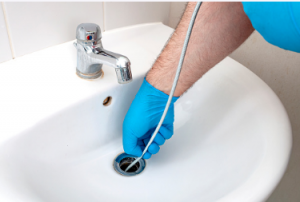Many homeowners experience blocked drains at some point. Depending on the cause, they can be a slow, gradual process or a sudden, unforeseen occurrence. If you have blocked drains in your home, there are several steps you can take to ensure that they do not become blocked again. Read on for some simple yet effective steps. Also, remember always to wear protective gear, such as rubber gloves and safety glasses. Even if you don’t know what caused the blockage, calling a professional job is still important.
 If you have distinctplumbing.com.au blocked drains Adelaide in a single fixture, it is likely that the blockage is in the pipe that connects to the appliance. However, if you have multiple blocked drains, the problem is more likely to be in the sewer line. To check the cause of blocked drains, you can flush the toilet or run the taps. If the water in the sink or shower rises, the issue is likely to be in the sewer line.
If you have distinctplumbing.com.au blocked drains Adelaide in a single fixture, it is likely that the blockage is in the pipe that connects to the appliance. However, if you have multiple blocked drains, the problem is more likely to be in the sewer line. To check the cause of blocked drains, you can flush the toilet or run the taps. If the water in the sink or shower rises, the issue is likely to be in the sewer line.
Another easy way to clear a blocked sink is to use a wire coat hanger. Bend the wire over so that it forms a small hook. Then, push it through the drain cover to remove the gunk. Make sure to use hot water while fishing. Otherwise, you might cause the clog again. If you can’t solve the problem through a plunger, try using a drain snake. You can also use the tips above.
Caustic soda can clean drains, but it is important to use protective clothing and eye protection. In addition, caustic soda can cause chemical burns if it is not handled correctly. It is best to use boiling water as a flushing agent, but you should avoid using it if you’re allergic to chlorine or other chemical compounds. If you’re not confident with this method, you can try baking soda and vinegar instead.
Although unclogging a blocked drain can be a nuisance, it is far better than not having one. Blocked drains can cause a major flooding emergency if left untreated. In some cases, a plumber may be necessary, but sometimes you can do it yourself with a DIY solution. For example, you can boil water in a kettle to remove stubborn grease and other types of debris. Once you’ve used this solution and your drains are clear, you can use a plunger to unclog them.
Adding baking soda to boiling water is another simple method for unclogging a blocked drain. When dissolved in boiling water, the baking soda creates a bubbling reaction inside the drain, allowing it to unclog. After a few minutes, you can add more vinegar or boiling water to the mixture to get rid of odours. If this method doesn’t work, you can try using plain white vinegar instead.
Another useful tool is a drain rod. You can purchase one at your local hardware store or even online. First, push the rod into the chamber that’s blocked. Then, rotate it clockwise to dislodge the blockage. Be careful not to push the rod too far against the drain, as this may cause the plunger attachment to become loose. Eventually, repeated thrusts of the rod into the blockage will free it. This method may take some time but is guaranteed to work.
Foreign objects are another common cause of blocked drains. These items can clog the drainpipe, resulting in overflowing sewage. If you are trying to flush baby wipes, cotton pads, sanitary items, or toilet paper, avoid flushing these items down the toilet. Using a drain cleaning tool to remove these items will help keep your home safe from blocked drains. When flushing, remember to follow the instructions on the packaging.
You can also use boiling water to flush a blocked drain. This method is most effective on metal pipes. On the other hand, PVC pipes are sensitive to extremely hot water. Warm water is best for this type of flush. Once the water is boiling, it will dissolve the debris trapped inside. After that, the drain should be clear. If that doesn’t work, you can also try mixing 1/2 cup of baking soda in hot water and pouring it into the sink. A plumbing tool or a plunger may be necessary.